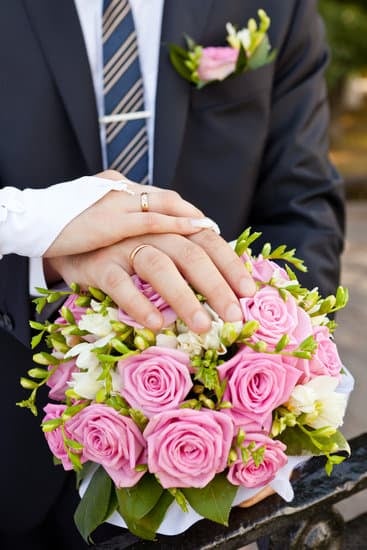The tradition of wedding rings holds a significant place in the hearts and minds of couples as they embark on their journey of marriage. But when it comes to the question, “does the bride pay for the groom’s wedding ring?” there is often confusion and debate. In this article, we will delve into the historical background, traditional etiquette, modern trends, and personal perspectives surrounding this age-old tradition.
Wedding rings have been exchanged between couples for centuries, symbolizing love, commitment, and an eternal bond. The tradition dates back to ancient Egypt and has evolved over time to become a cornerstone of wedding ceremonies worldwide. However, as societal norms have shifted and financial dynamics have changed, questions about who pays for what in a wedding have also emerged.
Understanding the complexities of wedding ring traditions is crucial for couples as they navigate this milestone in their lives. From historical origins to modern trends, this article aims to provide insight into the etiquette surrounding wedding rings and offer practical advice for planning and budgeting for this meaningful purchase. Let’s explore the nuances of this enduring tradition and unravel the debate around who pays for the groom’s wedding ring.
Historical Background
The tradition of exchanging wedding rings dates back to ancient Egypt, where reeds and other plants were twisted and braided into circles to symbolize eternity. These early rings were often worn on the fourth finger of the left hand, as it was believed that a vein in this finger led directly to the heart. The Romans later adopted this custom, using more durable materials like iron and gold for their rings.
Over time, the significance of wedding rings evolved to represent love, commitment, and fidelity between partners. The circular shape of the ring came to symbolize eternity and never-ending love, while the wearing of the ring on the left hand’s fourth finger persisted through various cultures.
As the tradition spread to other parts of the world, customs surrounding wedding rings also varied. In some cultures, only one partner would receive a ring during the ceremony, while in others both partners exchanged rings. Despite these differences, the underlying symbolism remained consistent: a tangible symbol of love and commitment between two people.
It is interesting to note that historically, it was more common for brides to receive a wedding ring while grooms did not. This practice has shifted over time, leading to debates about modern expectations regarding who should pay for what in terms of wedding expenses.
| Historical Background | Origins of Wedding Rings |
|---|---|
| The tradition originated in ancient Egypt | Symbols of eternity and never-ending love |
| Wearing on left hand’s fourth finger | Variations in customs around different cultures |
Who Pays for What
Traditionally, the cost of the wedding bands is one of the responsibilities that the groom bears. This tradition harkens back to ancient times when a groom would offer valuable gifts, such as precious metals or jewelry, to prove his ability to take care of his bride. While this tradition has evolved over time, with more couples sharing financial responsibilities, it remains common for the groom to pay for both his own ring and the bride’s ring.
In most traditional wedding etiquette, the groom also covers other wedding expenses such as the marriage license, officiant fees, and the bride’s bouquet. However, with shifting gender roles and financial dynamics in modern relationships, these guidelines are not set in stone. Many couples today choose to divide all wedding expenses equally or based on their individual financial situations.
According to a study by The Knot, in 2019 more than half of engaged couples contribute financially to their own nuptials while only 10% reported having all wedding costs covered by parents or others. When it comes down to who pays for what in a wedding, traditions have significantly shifted from being solely the responsibility of one party towards becoming an equal partnership between both partners.
| Traditional Wedding Expenses | Responsibility |
|---|---|
| Wedding bands (Bride & Groom) | Groom |
| Marriage License | Groom |
| Officiant Fees | Groom |
| Bride’s Bouquet | Groom |
Modern Trends
In today’s modern society, traditional wedding customs and etiquette are constantly evolving. This includes the longstanding tradition of the groom buying the bride’s engagement ring and wedding band, while the bride is responsible for purchasing the groom’s wedding band. However, with changing gender roles and societal norms, this tradition is being reevaluated by many couples.
One major shift in wedding ring etiquette has been the move towards more equality in sharing financial responsibilities. Many couples are choosing to split the cost of both the bride and groom’s wedding rings, as a symbol of their partnership and commitment to sharing their lives together. According to a survey conducted by The Knot, nearly 45% of couples now opt for this modern approach to purchasing wedding bands.
Another trend that has emerged in recent years is choosing alternative metals and designs for wedding bands, rather than sticking to traditional gold or platinum bands. This shift allows couples to consider a wider range of options that fit their personal style and budget, regardless of who ultimately pays for the rings.
Ultimately, these changes reflect a broader societal shift towards more egalitarian relationships and shared decision-making within marriages. As couples continue to redefine what marriage means to them, it is natural that traditional customs surrounding wedding ring etiquette will also continue to evolve.
The Debate
The tradition of exchanging wedding rings dates back centuries and has always been a symbol of love and commitment. However, as times have changed, so have the traditional customs surrounding the purchase of wedding rings. One lingering question that often arises is whether the bride should pay for the groom’s wedding ring.
Historical Perspectives
In the past, it was customary for the groom to bear the financial responsibility of purchasing both the bride’s engagement ring and wedding bands for both partners. This tradition stemmed from historical gender roles and societal expectations. However, as society has evolved, so has the perception of who pays for what in a modern relationship.
Modern Expectations
With changing expectations and roles within relationships, there has been a shift in wedding ring etiquette. Many couples now opt to split the cost of their wedding rings or take turns covering different aspects of their wedding expenses. The idea of equal partnership and shared financial responsibilities has become more common, leading to discussions about whether it is fair for one person to shoulder all the financial burden for such significant purchases.
Personal Perspectives
When it comes to real-life experiences, opinions are diverse. Some couples adhere to traditional customs, with the groom paying for both rings. Others believe in equal contribution and sharing expenses when it comes to purchasing wedding rings. Ultimately, there is no one-size-fits-all answer, and each couple must consider their own values, beliefs, and financial situation when deciding who pays for the groom’s wedding ring.
As traditions continue to evolve in today’s society, it is essential for couples to communicate openly and honestly about their expectations regarding wedding ring expenses. Ultimately, what matters most is that both partners feel comfortable and secure in their decision regarding this significant purchase.
Personal Perspectives
When it comes to the age-old question of who pays for the groom’s wedding ring, there are a variety of perspectives and experiences from couples that can shed light on this topic. For some couples, the tradition of the bride paying for the groom’s ring may hold significance, while for others, modern trends and financial practicalities may take precedence.
Here are some real stories and experiences from couples that showcase the different approaches to this tradition:
- Some couples adhere to traditional expectations, where the bride pays for the groom’s wedding ring as a symbol of commitment and mutual investment in their future together.
- On the other hand, there are couples who choose to split the costs equally or take turns paying for each other’s rings as a demonstration of equality and shared responsibility in their relationship.
- In some cases, factors such as individual financial situations, personal preferences, and cultural backgrounds play a significant role in determining who ultimately bears the cost of the groom’s wedding ring.
Regardless of who pays for the groom’s wedding ring, it is evident that each couple approaches this decision differently based on their unique circumstances and values. The personal perspectives of these couples highlight that there is no one-size-fits-all answer to this question, and ultimately, what matters most is what feels right for the individuals involved.
Practical Considerations
When it comes to planning a wedding, there are many practical considerations that couples need to take into account. One of the most important aspects to consider is the budget for wedding rings and overall financial planning.
Traditionally, the groom was responsible for purchasing both the bride’s engagement ring and the wedding bands for both partners. However, in modern times, there has been a shift in this tradition, leading to the question: does the bride pay for the groom’s wedding ring?
In today’s world, many couples are choosing to split the cost of both engagement rings and wedding bands. This decision often comes down to individual preferences, financial situations, and personal beliefs about equality within the relationship. Some may argue that since the bride’s engagement ring is typically more expensive than the groom’s, it makes sense for them to contribute towards the cost of his ring as well.
Moreover, with changing societal norms and gender roles, there is a greater emphasis on fairness and equality within relationships. As such, it is becoming increasingly common for couples to have open discussions about their financial responsibilities when it comes to purchasing wedding rings.
These conversations can help establish mutual understanding and ensure that both partners feel comfortable with their respective financial contributions towards these important symbols of commitment. Ultimately, whether the bride pays for the groom’s wedding ring or not is a decision that should be made collaboratively between both individuals based on their unique circumstances and beliefs.
Advice and Recommendations
Communicate and Compromise
When it comes to deciding who pays for the groom’s wedding ring, communication and compromise are key. It’s essential for couples to have an open and honest conversation about their expectations, beliefs, and financial situation.
Some couples may agree that the bride will pay for the groom’s wedding ring, while others may decide to split the cost evenly. By being transparent about their individual perspectives, couples can work together to find a solution that feels fair and comfortable for both parties.
Consider Individual Financial Circumstances
Another important factor to consider when determining who pays for the groom’s wedding ring is each person’s financial circumstances. It’s crucial for couples to take into account their individual budgets and financial responsibilities before making a decision.
If one partner is financially capable of covering the cost of both rings, they may choose to do so as a gesture of love and commitment. On the other hand, if both partners are on equal financial footing, they may opt to share the expenses equally.
Seek Advice From Married Couples
For soon-to-be-married couples facing this decision, seeking advice from friends or family members who have already navigated this issue can be incredibly helpful. Hearing about real-life experiences and perspectives can provide valuable insight and guidance.
While every couple’s situation is unique, learning from the experiences of others can help shed light on different approaches to handling wedding expenses such as the groom’s ring. Ultimately, it’s important for each couple to find a solution that aligns with their values, beliefs, and financial circumstances.
Conclusion
In conclusion, the question of whether the bride should pay for the groom’s wedding ring is a complex and nuanced issue that reflects the evolving nature of wedding traditions. As we have seen, the historical background of exchanging wedding rings has shaped traditional expectations of who pays for what in a wedding. However, modern trends and changing societal norms have brought about a shift in wedding ring etiquette, leading to a debate on this particular topic.
While some may argue that the tradition of the groom purchasing the bride’s engagement and wedding rings should be reciprocated, others believe that these customs are outdated and do not reflect contemporary beliefs about equality and partnership in marriage. Ultimately, the decision of who pays for the groom’s wedding ring is a personal one that each couple must navigate based on their own values, financial situation, and relationship dynamics.
As couples consider this question, it is important to weigh practical considerations such as budgeting for wedding expenses and financial planning for their future together. Open communication and mutual understanding are crucial in making decisions about wedding ring purchases, as they serve as symbols of love and commitment in marriage.
Whether it is through sharing costs equally or finding alternative arrangements that suit both individuals, finding a solution that aligns with both partners’ needs can strengthen their bond as they embark on this new chapter together.
Frequently Asked Questions
Does the Bride Pay for the Groom’s Ring?
Traditionally, the groom is responsible for purchasing the bride’s engagement ring and wedding band, while the bride is responsible for the groom’s wedding band. This division of financial responsibility is an accepted tradition in many cultures.
Is the Bride Supposed to Buy the Groom a Ring?
While there is no hard and fast rule that the bride must buy the groom a ring, it has become increasingly common for both partners to exchange rings as a symbol of their commitment to each other. Many couples choose to mutually select and purchase each other’s wedding bands.
Does the Bride Carry the Grooms Ring?
The practice of the bride carrying the groom’s ring down the aisle is not uncommon. It often symbolizes her trustworthiness and willingness to care for her partner. However, different couples may have varying preferences when it comes to this tradition. Ultimately, it depends on what feels right for each individual couple.

I have been involved in marriages for over 20 years helping couples and singles understand more about them.





